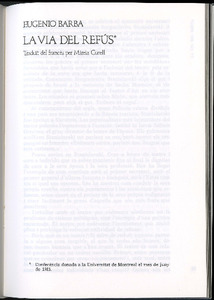La via del refús
Metadata
Show full item record
Estudis escènics: quaderns de l'Institut del Teatre. 1985, Núm. 27
Document typeArticle
Abstract
<p>In 1938, in Moscow, the 40th anniversary of Stanislavski's Theatre of Art was celebrated. Today, we can see in Stanislavski's attitude the example of how to behave before a prime secretary or army men regardless of their ideology. But, what's a theatre? Finally, only the actor remains, he is the only one capable of taking us to a different experience. In order to arrive to this situation it is necessary to pass through an unavoidable bridge, through a technique, that is, through a particular use of the body. We can then talk of bio-scene. At the beginning of the century, Stanislavski is famous but he is not satisfied because he does not have the secret of the creative act yet. He then moves to a tiny village in Finland. Back to Moscow, he already has the embryo of his «system». If I am a heir of Stanislavski's it is not so much for his answers as for his obsessions. I do not feel linked to a physical place, to a geographic entity with its own traditions, but to the country of speed. The first thing that must be imposed to the actor is self-discipline. Katsuki Azuma is one of the collaborators in the ISTA (International School of Theatre Antropology), and she is a teacher of Japanese classical dance; I look at Katsuko and think: the actor must assert with his right cerebral hemisphere that he is everything, and 106 with the left one feel that he is nothing at all. The most important thing is the motor; the actor may have a good disposition but he will not make any progress without a good motor. He must learn something different from what the teacher wants him to learn.</p>
Access conditionsOpen Access
ISSN2385-362X
,
0212-3819
Collections
- 1985: Núm.: 27 [7]


